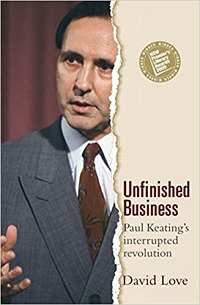There are no “good guys” in the brawl between the Labor and Liberal parties over the future of Australia’s compulsory superannuation system. As usual, both parties are pushing policies designed only to advantage the (largely overlapping) vested interests they serve, clothed in rhetoric designed to appeal to their supporters. The result is an intra-establishment bunfight in which both sides are simultaneously right and wrong: each right that the other’s arguments are bunkum, but neither willing to admit that compulsory superannuation is itself a fraud, designed from the outset to force working Australians to subsidise a parasitic financial services “industry” without being guaranteed a cent in return, in the hope enough remains of what they are forced to “save” that they might afford to live decently in retirement. Most, meanwhile, are unaware that for their entire working lives they have been paying extra tax intended to support a universal, non-means-tested pension that has been denied them for decades.

As it has been, on and off, for several years now, the present argument is over when and whether the so-called Superannuation Guarantee (SG) will be raised to 12 per cent of pre-tax wages. Labor had legislated in 2012 that this should be completed by 1 July 2019, but Liberal governments since 2013 have pushed back the schedule, and held the SG at 9.5 per cent. Annual 0.5 per cent rises were set to resume in July this year, to reach 12 per cent in 2025. But since late 2019 several members of the government have publicly mooted further delays, or even scrapping further increases altogether, and broadening the conditions under which super may be withdrawn early. The COVID-19 recession has put a sharp point on the argument.
Judging by a de facto policy statement by Minister for Superannuation Jane Hume in the 22 January Australian Financial Review, it seems the government has indeed decided at least to delay, and possibly to cancel further increases to the SG. Citing the “independent” Retirement Income Review led by retired senior Treasury official Mike Callaghan, commissioned in September 2019 and whose final report was published last November, Senator Hume argued that whilst “Australians are retiring with more savings than ever, … rather than maximising our standard of living in retirement by effectively using our retirement savings, an extraordinary number of retirees live unnecessarily frugal lives … [before] eventually dying with most of their savings still intact.” Therefore, “taking more money away from your standard of living today so you can retire with a higher balance” would only exacerbate the problem.
Eat your house
Instead of lifting the SG, Sen. Hume wrote, “the report pointed to other methods of improving retirement savings, noting that if the ‘rate of employer contributions to super remained at 9.5 per cent and people made more efficient use of their retirement savings, many would have higher replacement rates than they would have with the SG at 12 per cent and drawing down their balances at the legislated minimum rate’.” How serendipitous, then, that in last year’s budget the Morrison government expanded the Pension Loans Scheme (PLS), a government-run “reverse mortgage” system under which retirees can cash in equity in their home or other real estate holdings, which the government recoups from the sale of said asset after they die. “Thanks to changes made by the Coalition around two years ago, the cost-effective scheme is open to all Australian retirees”, wrote Hume. “A low-return world [due to record low interest rates] may be here for some years to come”, she added. “But with innovative responses … [we can] ‘smooth the curve’ of lifetime consumption and living standards … without needing to save ever more and consume less in our working lives.”

Former PM Paul Keating, who introduced compulsory superannuation contributions in the 1990s, called out the government’s real agenda in his own 27 January AFR column. “Hume argues superannuants should be slaked of all super accumulation before they die”, he wrote. “‘Efficiency’ … [is] to burn through the income and the underlying superannuation capital, so you die without a dollar to your name or for your spouse or dependant or dependants.” And just to “make sure working people get the message”, Keating went on, “Callaghan in his report informs them they can reverse-mortgage their house if they run short”. And most retirees would surely be forced to do so, he pointed out, given that as of 2018 men over 75 had a median super balance of only $200,000, and women the same age just $126,000; hardly the excessive savings of Hume’s imaginings. Author and former investment banker Satyajit Das, writing 4 February in the AFR, concurred with Keating’s analysis, noting that average super amounts are “artificially skewed by a small pool of people with large balances”, and even so are “well below the $600,000 to $700,000 estimated to be necessary for home-owning and debt-free couples to finance their retirements”. And to make matters worse, as AFR business columnist Karen Maley pointed out the same day, Hume’s “efficiency” also requires retirees to purchase a “longevity product”, known as a group self-annuitisation (GSA), “which will provide them with an income in case they happen to live past the age of 92—the point where their super savings run out.”

“And this is where things get tricky”, Maley wrote: “at present, such financial products don’t exist and it’s impossible to buy one. They are only theoretical.” And if and when they do exist, like existing super accounts they will be subject to market and inflation risks, and thus have no guaranteed rate of return. Das, an expert in complex financial instruments, opined that the inherent risks of such products would be so great that no bank would touch them without “government support or guarantees”, further adding to their cost to state coffers. And even were the scheme somehow to come off, it would only accelerate the economy on its downward spiral. “[The] strategy entails running down the wealth stock of a country as savings are used up and houses sold”, he wrote. “In effect, capital is consumed to finance current expenditures. In aggregate, the running down of savings will affect available investment resources across the economy…. The problems highlight failures in economic and social policy. Low wage growth and lack of income security combined with consumerism has meant inadequate savings. Absurd economic policies over decades has reduced investment income and cash flow. It has exaggerated housing prices, which are now apparently to be used to cover insufficient savings and inadequate investment cash flow earnings.”
A Macquarie Bank scam
Whilst it can thus be seen that ultimately such a policy will benefit no-one, its immediate—and presumably intended—effect will be to prop up Australia’s housing bubble, and thus the major banks that depend upon continual turnover of residential mortgages to maintain their illusion of solvency. The effect would be even more pronounced should the government adopt a proposal by a gaggle of Liberal backbenchers, led by Victorian MP Tim Wilson, to allow first home buyers to drain their super for a deposit. Wilson complains in a 23 November YouTube video that “The super sector spends hundreds of million from your savings on advertising campaigns” to scare up support for a 12 per cent SG, while “for up to 50 years they take fees from your salary and pay themselves big fees, and big bonuses”. All true—including of the “not-for-profit” Industry Super funds, albeit to a considerably lesser extent than their bank-owned brethren. But then, such has been the purpose of compulsory super from the outset.
The truth about Keating’s super scheme, as the Citizens Party (then Citizens Electoral Council) reported when Labor announced its plan for a 12 per cent SG 2011,1 is inadvertently revealed in the book Unfinished Business: Paul Keating’s interrupted revolution (Melbourne: Scribe Publications, 2009), by shameless Keating groupie David Love. Keating pushed compulsory super, Love wrote, because “unless the growth in savings—and therefore in financial capital—continued to accelerate, Macquarie [Bank] and institutions like it could not manage to sustain the momentum of the growth in their overseas operations, and Keating wanted these as a new Australian industry” to replace the manufacturing, agricultural and other sectors he and Hawke deliberately smashed with their disastrous neoliberal “reforms” beginning in 1983. Those reforms were based on the recommendations of the 1981 Campbell Report commissioned by then-Treasurer John Howard but rejected by PM Malcolm Fraser, which Keating re-badged as the “Martin Review” to disguise its Liberal origins, and they continued seamlessly under Howard when he succeeded Keating as PM in 1996. The principal architects of virtually all those reforms—the floating of the dollar, financial deregulation, “National Competition Policy”, mass privatisation of public assets and services, and of course super—were all executives of Macquarie Bank (or Hill Samuel Australia, as it was previously known), which has also been the reforms’ principal beneficiary. Meanwhile, as illustrated by huge super losses in the 2007-09 global financial crisis, the public who are forced to support Macquarie et al.’s gambling habits are left entirely to the mercy of the financial markets.
‘Age pension is a right’
Super is doubly a scam given that as advocacy group Australian Pensioners’ Voice (APV) pointed out in a 28 February 2020 press release, “the Age Pension is a right, and not a charity or ‘welfare’. … Working Australian taxpayers have been contributing to their own retirement for over 70 years.”

During World War II, Labor PM John Curtin and Treasurer Ben Chifley succeeded in bringing all personal and company income taxes (some of which had previously been a state responsibility) under the authority of the Commonwealth. Their National Welfare Fund Act of 1943 stipulated that a certain portion of these taxes or an appropriation from Consolidated Revenue be set aside each year to fund “such payments as are directed by any law of the Commonwealth … in relation to health services, unemployment or sickness benefits, family allowances, or other welfare or social services.” In 1945 the act was amended to include invalid, old-age and widows’ pensions; and instead of a fixed appropriation, the fund was allocated the proceeds from both company payroll tax and a separately legislated levy of 7.5 per cent across all income tax brackets. And as APV Secretary Gino Iannazzo pointed out, whilst Liberal PM Robert Menzies tipped the National Welfare Fund back into Consolidated Revenue in 1949 and later imposed an income test to pensions, to which Hawke and Keating added an asset test in 1985, “It’s important to note that the 7.5 per cent additional tax levied by Ben Chifley was not altered by these changes and continues to be collected to this very day!” In light of which the real “Super Guarantee” is already 17 per cent, not 9.5. And to add insult to injury, as former Treasury economist Leith van Onselen reported 28 January for MacroBusiness, the Treasury’s own figures show that the lion’s share of superannuation tax concessions, many of which were put in place to encourage voluntary contributions atop the compulsory ones, naturally flow to the rich, who can simply shovel mountains of money into their super at a flat 15 per cent tax rate instead of their normal income-tax bracket. As a result, “taxpayers spend at least twice as much supporting the retirements of the top 1 per cent of income earners as they spend on someone receiving the age pension. Looking at superannuation specifically, the top 1 per cent of income earners are projected by the Treasury to receive more than $700,000 in superannuation concessions over their working lives, roughly 14-times the $50,000 of concessions received by the bottom 10 per cent of income earners.” Not only that, van Onselen notes in a separate 27 January report, but the Callaghan review itself, also citing Treasury estimates, admits that super concessions alone will cost more in the long term than they save in Aged Pension payments.
A system that inhibits wage growth, crimps tax revenues, forces workers to sponsor financial parasites, and ends up costing more than it saves anyway, is a system that should not exist. Compulsory superannuation has failed miserably in its objective of funding adequate retirements for all Australians; most Australians would be better served by an adequate universal aged pension, properly indexed to the actual inflation rate (not artificially lowered CPI), in an economy with affordable housing so they retire owning their own homes.
By Richard Bardon, Australian Alert Service, 10 February 2021
Footnote:






